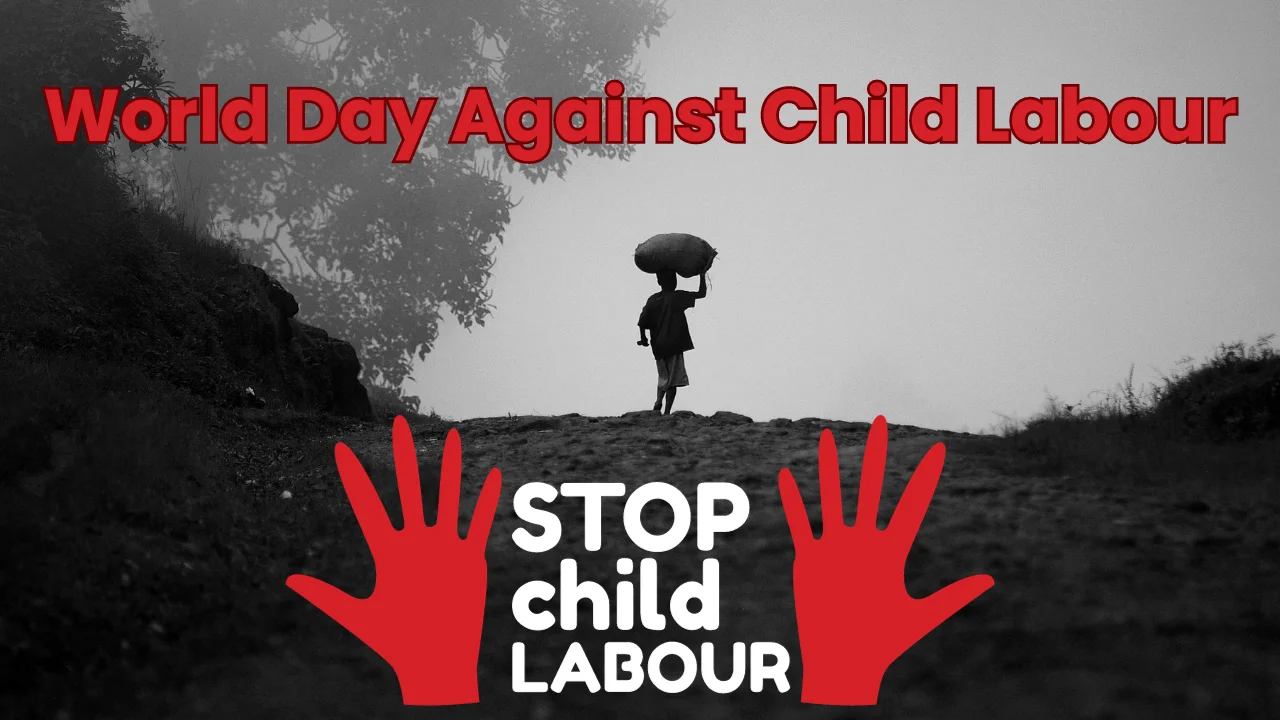World Day Against Child Labour 2024
World Day Against Child Labour is an annual observance held on June 12 to highlight the plight of child labourers and to promote efforts to eliminate child labour. The day was first proclaimed by the International Labour Organization (ILO) in 2002.
The abolition of child labour is indeed a fundamental aspect of the pursuit of social justice. It represents the belief that every worker, regardless of age, should have the freedom and equal opportunity to receive their fair share of the wealth they have contributed to generating. By eradicating child labour, we strive to create a society where all individuals, including children, are treated with dignity and have access to quality education, adequate living conditions, and opportunities for personal development. This vision of social justice encompasses the idea that everyone deserves a fair and equitable chance to prosper and thrive, unburdened by the exploitation of child labour.
World Day Against Child Labour Theme 2024
The official theme for World Day Against Child Labour 2024 is “Let’s act on our commitments: End Child Labour!”.
This day presents a vital opportunity to raise awareness, advocate for change, and contribute towards a future free from child labour.
Prevalence of Child Labour
- Child labour continues to be a significant global challenge, despite the progress made in previous years.
- Factors such as conflicts, crises, and the COVID-19 pandemic have pushed more families into poverty, leading to an increase in child labour.
- Economic growth, while important, has not been sufficient or inclusive enough to alleviate the pressures that drive families to rely on child labour as a means of survival.
- Currently, approximately 160 million children worldwide are engaged in child labour, which accounts for almost one in ten children globally.
- The regions most affected by child labour are Africa and the Asia-Pacific region.
- Africa has the highest percentage of children in child labour, with one-fifth of all children in the region engaged in such work.
- In absolute terms, Africa also has the highest number of children in child labour, with 72 million affected.
- Asia and the Pacific follow closely behind, with 7% of all children in the region and 62 million in absolute terms engaged in child labour.
- Together, these two regions account for nearly 90% of all children in child labour globally.
Child labour is a visible manifestation of the larger issues of poverty and exclusion. It denies children access to education and opportunities, placing them at a disadvantage in securing decent incomes and stable employment in adulthood. While child labour primarily affects households and families, it also hinders the economic growth of entire countries and contributes to rising inequality worldwide. It poses a threat to social cohesion and impedes overall human progress. Addressing child labour requires comprehensive efforts to tackle poverty, promote education, and ensure opportunities for decent work and economic development.
History of World Day Against Child Labour
The World Day Against Child Labour has a significant history dating back to 2002 when it was first observed. The International Labour Organization (ILO) established this annual event to raise awareness and mobilize efforts to combat child labour worldwide.
- The choice of June 12th as the designated day is symbolic.
- It was on this day in 2002 that the ILO adopted Convention No. 182, which is a key international instrument focused on eliminating the worst forms of child labour. This convention highlights the urgency of addressing child labour and provides a framework for governments, employers, and workers to work together in combating this issue.
- Since its inception, the World Day Against Child Labour has been observed globally with various activities, campaigns, and initiatives organized by governments, international organizations, civil society groups, and individuals.
- The initiative aligns with the Sustainable Development Goals (SDGs) adopted in 2015, which include a commitment to ending child labour. Target 8.7 of the SDGs emphasizes the need to take immediate and effective measures to eliminate forced labour, modern slavery, human trafficking, and the worst forms of child labour, including child soldier recruitment. The target also aims to completely eradicate child labour in all its forms by 2025.
- These efforts aim to raise awareness, promote advocacy, and generate actions to protect children from exploitation and ensure their right to education, health, and safe childhood.
Over the years, World Day Against Child Labour has contributed to increased global attention on child labour issues and has played a crucial role in driving collective action to eradicate this violation of children’s rights. It serves as a reminder of the ongoing challenges and the need for sustained efforts to create a world free from child labour.
Significance of World Day Against Child Labor
The World Day Against Child Labour holds immense significance in the global effort to eliminate child labour and protect the rights of children. It serves as a reminder of the urgent need to address this issue and highlights the following key aspects:
- Awareness and Advocacy: The day raises awareness about the prevalence and consequences of child labour, ensuring that the public, governments, and organizations remain informed about the gravity of the problem. It provides a platform to advocate for the rights of children and mobilize action against child labour.
- Global Solidarity: The World Day Against Child Labour promotes global solidarity by bringing together governments, employers, workers, civil society, and individuals to collectively work towards eradicating child labour. It encourages collaboration and cooperation among stakeholders to develop strategies and policies that prioritize the well-being and protection of children.
- Policy and Legislative Action: The day underscores the importance of effective policies and legislation to combat child labour. It calls for the ratification and implementation of international conventions and laws aimed at eliminating child labour and providing children with access to education, healthcare, and a safe environment.
- Sustainable Development: Child labour is closely linked to poverty, inequality, and lack of access to education. The World Day Against Child Labour emphasizes the connection between child labour and sustainable development. By addressing child labour, societies can foster inclusive growth, reduce poverty, and promote social justice.
- Child Rights and Well-being: The day focuses on the rights and well-being of children. It highlights the impact of child labour on their physical, mental, and emotional development. It emphasizes the importance of creating safe and nurturing environments that enable children to thrive, receive education, and have opportunities for a better future.
12th June 2024 Special Day
June 12th carries global humanitarian significance as the International Labour Organization commemorates World Day Against Child Labour in 2024. Coinciding poignantly with late spring annually, this observance confronts the stark reality of children exploited as labourers worldwide. The unique timing provides an opportune moment to catalyze efforts protecting child rights while spreading awareness to end abusive practices. As activists and communities coordinate internationally on this particular 2024 date, the message resonates clearly – child labour hinders human progress.
- Indian Bank Recruitment 2025 Out for 1500 Apprentice Posts
- Indian Bank Apprentice Salary 2025, Pay Scale, Salary Structure
- Indian Bank Apprentice Syllabus & Exam Pattern 2025, Check Details
- Railway RPF Syllabus 2024, Check Exam Pattern, Topic And Syllabus
- SSC JE vs RRB JE, Which Is Better? Know Detailed Comparison
- SSC CGL Study Plan 2025 For Next 25 Days With Tips, Tricks

Hello, I’m Aditi, the creative mind behind the words at Oliveboard. As a content writer specializing in state-level exams, my mission is to unravel the complexities of exam information, ensuring aspiring candidates find clarity and confidence. Having walked the path of an aspirant myself, I bring a unique perspective to my work, crafting accessible content on Exam Notifications, Admit Cards, and Results.
At Oliveboard, I play a crucial role in empowering candidates throughout their exam journey. My dedication lies in making the seemingly daunting process not only understandable but also rewarding. Join me as I break down barriers in exam preparation, providing timely insights and valuable resources. Let’s navigate the path to success together, one well-informed step at a time.






